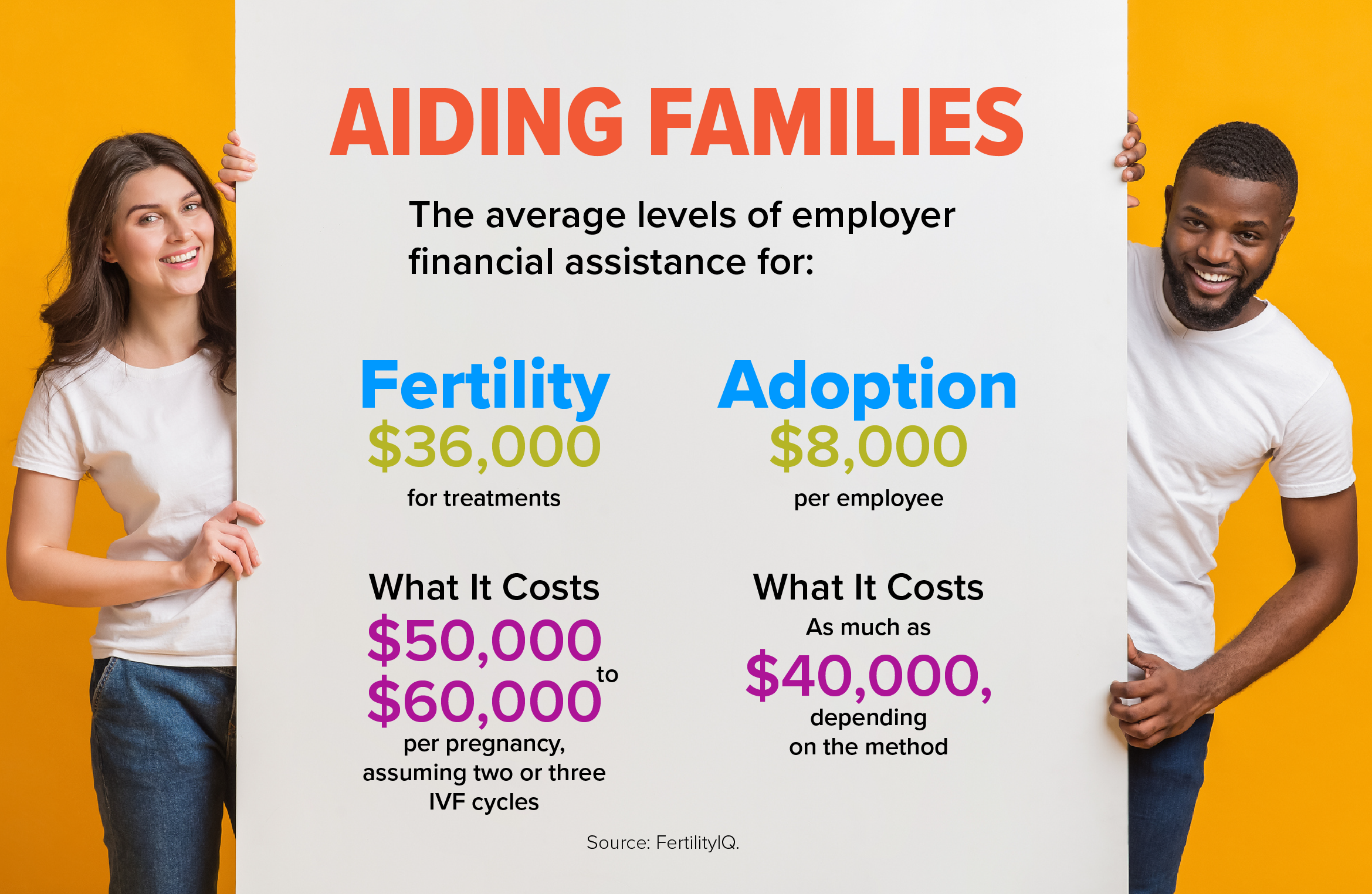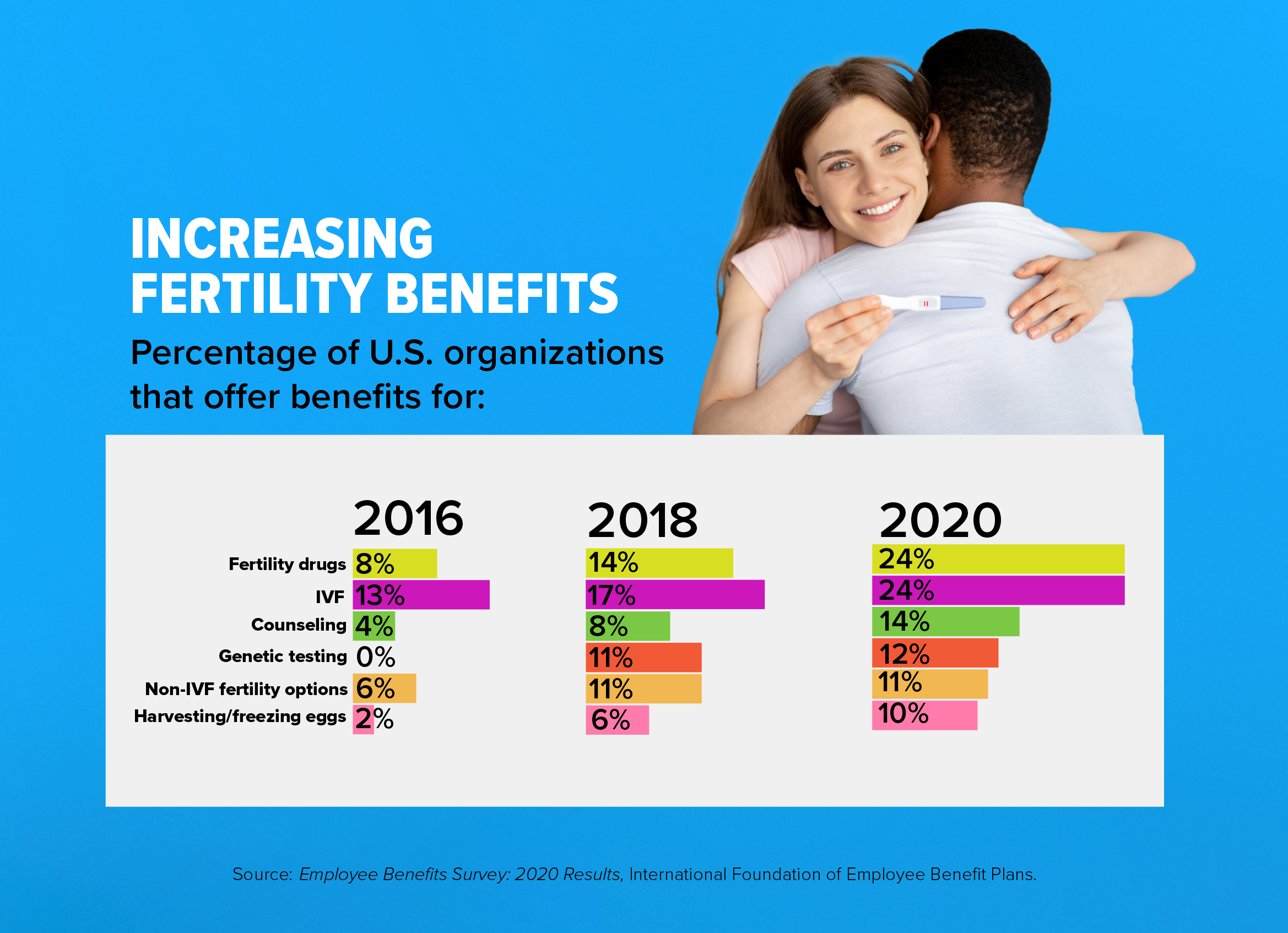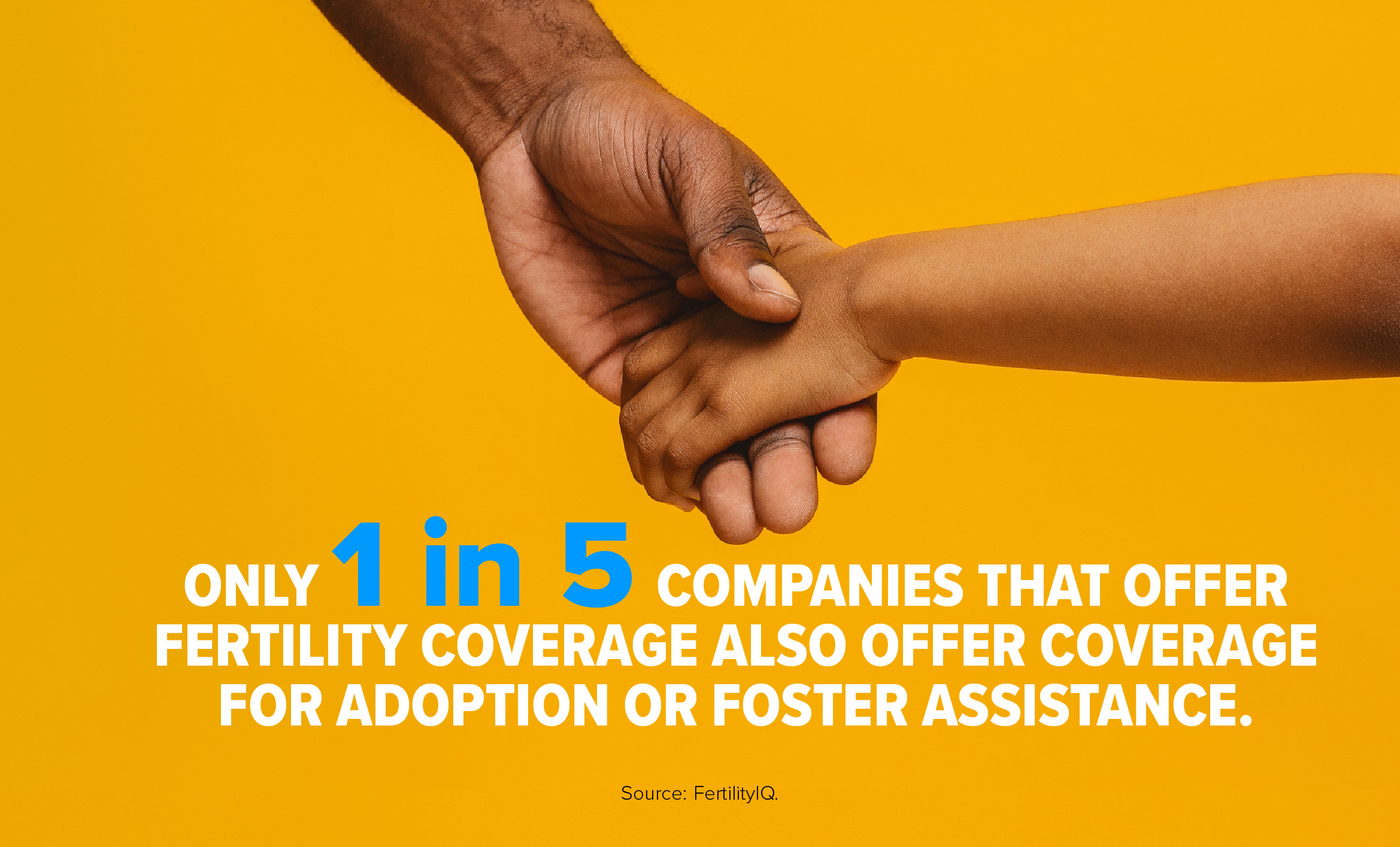Family-Building Benefits
Employers increasingly are recognizing the importance of supporting their workers through the emotional and financial challenges of family-building.
Jennifer and Rob Taylor of Snyder, Texas, completed fertility treatments and experienced a miscarriage during their first six years of marriage. They considered but ruled out in vitro fertilization (IVF) before shifting their focus to international adoption.
Today, they are the parents of three children—Emily, 9; Olivia, 8; and Henry, 6—all adopted from China. They credit Rob's employer, AT&T, with helping them to grow their family.
Rob qualified for reimbursement of a portion of the adoption expenses for each child—$5,000 at the time, a sum AT&T says it has since nearly tripled to $14,000. Coupled with the federal adoption tax credit, the workplace benefit made a critical difference in the Taylors' ability to adopt their three children between 2014 and 2017.
The impact of the support was "huge," Jennifer Taylor says. "I'm a dreamer. My attitude is always 'we'll figure it out.' But my husband is a numbers person, and he needed to see that we could really make it work. The reimbursement was crucial in getting over the hurdle because, with the help of the government and AT&T, we were halfway there in covering our costs."
Employers increasingly are recognizing the importance of supporting their workers through the emotional and financial challenges of family-building. Changes in technology and society mean that more people are growing their families through adoption or via medical interventions to improve the odds of conception and childbirth.
In 2020, 30 percent of U.S. organizations offered fertility benefits to their employees and 17 percent offered financial assistance with adoption, according to an annual survey conducted by the International Foundation of Employee Benefit Plans.

Adoption and infertility are "given different levels of respect," says Jake Anderson-Bialis, co-founder of FertilityIQ, which tracks employee benefits for fertility and adoption. "It's a double standard."
The number of organizations offering such benefits has grown steadily over the past five years, however, and LGBTQ and single employees are increasingly eligible, the International Foundation of Employee Benefit Plans noted.
There can be barriers to access, though, even at companies that boast of excellent benefits, Anderson-Bialis explains. Companies may require a diagnosis of primary infertility before fertility benefits can be used, which shuts out singles who want to have children on their own, as well as LGBTQ families. And fertility and adoption benefits are generally the province of large employers.
"Almost never do you see a company with under 5,000 employees covering adoption or fertility unless there is state legislation that compels it," Anderson-Bialis says.
A Crucial Benefit
Ferring Pharmaceuticals USA, a leader in reproductive medicine, has just 700 U.S. employees. But the Parsippany, N.J.-based company has acted on the principle that when building families is your cornerstone business, it's important to walk the walk.
Ferring offers its U.S. employees "a comprehensive family-building package," covering both fertility and adoption, says Karen Gehrig, director of employee benefits.
Ferring imposes no waiting period for access to its benefits. In addition to extensive options for fertility treatments, it provides up to $25,000 in adoption expense reimbursement. Employees can take advantage of these services the minute they walk in the door. They can also qualify for eight weeks of fully paid parental leave under the Family and Medical Leave Act once they've been on board for one year, Gehrig says.
Ferring's fertility benefits have evolved over time. "As treatments and technologies have expanded, we've expanded the benefit," Gehrig says. Ferring offers access to fertility services regardless of diagnosis to allow single employees and LGBTQ individuals to use the benefits. Also, many people are starting families later and may be concerned about their future ability to conceive, she notes, so Ferring added egg-freezing benefits in response to this concern.
"We recognize that there are a lot of different ways to build a family, and providing these benefits really supports our 'people come first' philosophy," Gehrig says.
Expanding Coverage
One segment of the population where family-building is rapidly expanding is in the LGBTQ community. A 2019 survey conducted by the Family Equality Council found that among members of the LGBTQ community ages 55 and over, 33 percent already had or were considering having children. Among those 18 to 35, the proportion spiked to 77 percent. A majority of respondents of all ages—63 percent—said they're looking to foster care, adoption and assisted reproductive technology to grow their families
Kim and Barbara Wilson, a same-sex couple in Orlando, Fla., have relied on benefits through Kim's job as a Southwest Airlines flight attendant as they build their family.
Five years ago when Kim was 34, they underwent IVF and froze seven viable embryos to preserve their options. After getting married in 2018, they both went on Southwest's insurance plan, which provides a $20,000 per-person lifetime maximum toward fertility treatments. Today, they have a 2-year-old daughter named Brooklyn, and they plan to soon try for a baby boy by transferring two embryos.
Kim carried their first child. For the next pregnancy, it's Barbara's turn, using Kim's embryos. But they know there's no guarantee of success. Although Kim got pregnant on the first IVF transfer, Barb says she is aware that the plan to transfer two male embryos could fail to produce a baby at all.
Barb, who works for an engineering firm, says it was particularly important that their Southwest health insurance covered pre-genetic screening. This allowed their embryos to be tested for viability, improving the odds of achieving a successful pregnancy. Nine of their 16 original embryos stopped growing after five days in the lab, and testing confirmed these embryos were not candidates for transfer.
The costs add up quickly. The price for the IVF treatments five years ago was around $9,000; prescriptions ran about $3,400. And then there are unexpected expenses. When a hurricane blew out their power, the Wilsons had to buy a generator to keep their fertility drugs at the correct temperature. But it was all worth it.
"It's been family-altering on my side," Barb says, explaining that having a baby helped her father accept her marriage to Kim. "He's such a proud papa."
Barb notes that although her employer does not offer IVF, "they will pay me fully for being off work." The engineering firm recently added fully paid parental leave in response to suggestions from several employees.
Both Barb and Kim speak in awed tones about the fertility benefits Southwest is providing. "I'm just blown away," Kim says. "They made it possible for us to have children."
'Insurance Paternalism'
Dr. Samuel Brown, who runs Brown Fertility, the Orlando clinic where the Wilsons were treated, says only 40 percent to 50 percent of the patients he encounters have coverage for fertility treatments, other than diagnosing problems. He blames an "insurance paternalism" mindset for treating fertility like an elective procedure that people could easily do without, while insurance providers continue to cover treatment for sexual health issues, such as erectile dysfunction medications.
"What employers don't see is that their employees are suffering and grieving," Brown says. "Infertility overwhelms the mind and can make it difficult for workers to concentrate on their job." This can be very destabilizing for employers, because "What do all [these employees'] friends and families say? Quit work." That is not a solution, he adds, because "stress doesn't cause infertility, but it can make you reluctant to seek advice."
Many patients, Brown adds, come to his practice expecting to have to mortgage their homes in order to afford treatment—and, moreover, they are willing to do so. He deliberately keeps rates at his clinic below average to improve access to fertility treatment, and he'd like to see more employers do their part.
"If you want happy employees for the long term, fertility coverage is important," Brown says.

Costs and Complications
Aimee Comer remembers sitting down with her CEO in 2008 to help construction company Robins & Morton put together its first package of adoption and fertility benefits.
"It all started with a conversation about the cost of family-building," recalls Comer, vice president of people and development at the Birmingham, Ala., company. "He wanted to make sure that if employees wanted to start families, they didn't have a financial barrier between that decision and wanting to make it happen."
Today, Robins & Morton, which employs 1,200 workers in 38 states, covers 100 percent of fertility expenses and pays $10,000 toward each adoption.
When the company first assembled its fertility and adoption benefits, Comer had no expectation that she'd be using the benefits herself seven years later. She learned firsthand how valuable those benefits were when her family adopted then-6-year-old Lucy from China in 2015.
"It's not cheap to adopt, and it's not simple either," Comer says. She received unlimited time off prior to the adoption to deal with home studies, stacks of paperwork and the 18-day trip to China. When she got home, she was eligible for a $10,000 reimbursement to help defray adoption costs and 10 weeks of leave at full pay to help her expanded family bond.
The company doesn't limit how many times employees can use the benefits, Comer notes. Employees are eligible to use both fertility and adoption benefits upon hire, and it doesn't matter to the company whether they plan to add one child or six to the family. The company, which self-insures its employee health plan, leaves it to doctors to decide if a patient needs treatment.
Robins & Morton currently doesn't offer surrogacy coverage but hasn't ruled it out and can respond nimbly when employees identify a need.
"Being self-insured gives you a lot of flexibility to design a plan with features that might not be available in an off-the-shelf medical plan," Comer says.
 |
It's important for employers to understand the emotional turmoil their workers go through when growing their family proves difficult, says Jeannie Lloyd, SHRM-SCP, Two decades ago, as a newlywed in her late 20s, Lloyd and her husband went through three years of fertility treatment, high-risk pregnancies and miscarriages. "We wanted to start our family, and it just didn't come easily," she says. At the time, Lloyd was vice president of human resources for a small nonprofit that worked with abused and neglected children, which made her difficulties in getting pregnant even more poignant. Her husband worked for a large company with generous benefits. "I was on prescriptions that cost $5,000 a month, and I was paying around Fertility treatment "was exhausting, invasive and emotionally draining," Lloyd recalls. The treatment routine required blood draws three days a week in Columbus, Ohio, an hour from home. "You're taking shots every day. You're going to doctor's appointments every week. There is no private life anymore because it's all controlled by this quest. For most folks who are driven professionals, it's hard to recognize that creating your family is beyond your control." She went through seven insemination cycles before she had the successful pregnancy that delivered her oldest daughter, now 17, into the world. Her younger daughter and son, who are 16 and 10, arrived without medical intervention. She is convinced she would never have started her family without her husband's benefits. "There is no way we could have afforded seven rounds plus all the testing and treatment that went on beforehand," Lloyd says. —D.C. |
A Family-Focused Culture
Jennifer Taylor says AT&T's support during a long infertility and adoption journey strengthened the bonds between her family and her husband's workplace. Rob is currently in his 16th year at AT&T, and although their family is now complete, the overall benefits package has been important to his continued satisfaction, she says
AT&T's covered services include fertility medications and treatments, a concierge service to direct employees to facilities and resources, adoption reimbursement, surrogacy services, coverage for a doula (a professional labor assistant) during pregnancy and childbirth, and paid parental leave.
"It's not only a great talent attraction tool, but also a retention tool," says Candice Little, lead benefits strategy consultant for AT&T.
AT&T's array of reproductive benefits includes fertility preservation services because "if now isn't the right time for expanding your family, it doesn't mean you don't want to preserve the option for later," Little says. Coverage knits together reproductive health services with broader family support. With 230,000 employees, AT&T strives to reflect a diverse workforce, she adds. "We want to be equal and inclusive, no matter where they are on the family journey."

Gehrig says explaining Ferring Pharmaceutical's family-building benefits to new employees is one of the most satisfying parts of her job.
"When I'm going over the benefits package, there is a visible reaction to how these benefits support our people and our mission," she says. "It's a big morale booster. I think it gives us a real competitive advantage when we're talking to recruits and in retention, particularly with people who have used the benefits."
Fertility treatment is expensive for an individual, "but we have found it's a relatively small portion of our overall medical expense," Gehrig says. "You're taking a huge burden off of an individual."
Family-building benefits touch employees' lives in a deeply personal way, Comer says, and it's not unusual for workers to be vocal about their appreciation.
"We get notes written from ecstatic parents and even children who write us thank-you notes because they've been adopted," she says. "We do it because it's the right thing to do to help people expand their families without the financial burden."
She sees the benefits package as a reflection of the company's family-focused culture.
"An individual may not personally use the benefits, but it says something about the values of the company you've joined when you see those benefits," Comer says. Robins & Morton also celebrates families with baby and adoption showers, and employees pick up one another's workloads when their co-workers are out on parental leave.
Comer feels fortunate to have been involved when the benefits were being designed.
"I never thought I was going to be somebody who was using them," she says. "It makes you realize the possibilities."
Debra Cope is a freelance writer based in Washington, D.C.
Explore Further
SHRM provides advice and resources to help business leaders understand and manage workplace issues related to family-building employee benefits such as fertility treatments and adoption.
Toolkit: Managing Adoption Assistance Benefits
Learn about the types of adoption benefits available and the tax issues employers should consider when offering such benefits as financial assistance and paid or unpaid leave.
Managing Workers Undergoing Fertility Treatments or Surrogacy
Two of the most important actions managers can take to help anyone going through in vitro fertilization (IVF) or surrogacy is to keep the lines of communication open and to be flexible with work arrangements, experts say.
HR Q&A: Does the FMLA apply to absences due to infertility?
It could, depending on the circumstances. As with all medical absences, if the individual case meets the criteria for a serious health condition under Family and Medical Leave Act (FMLA) regulations, then it will qualify.
Sample Policy: Paid Parental Leave
This sample policy outlines the eligibility criteria and the duration of paid parental leave for employees following the birth of an employee's child or the placement of a child with an employee in connection with adoption or foster care.
Webcast: Why Inclusive Family-Forming Benefits Should Cover More Than Just IVF
Covered topics include how employee family-forming needs have shifted over time, what family-forming options are available beyond IVF, and how employers can implement solutions that improve inclusivity while managing high-cost health care claims.



